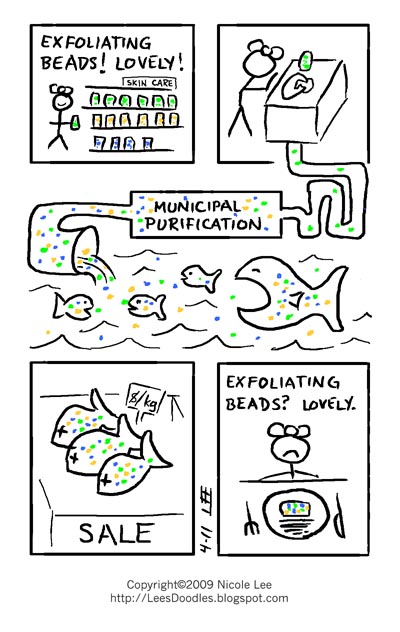From scrawlzine:
Okay. The big fish eat the little fish . But what do the little fish eat? Plastic. And where does the plastic come from? Chances are, you, if you used one of numerous body washes, face creams and anything else with exfoliating beads. While sewage treatment plants have filters that remove most large items such as soda bottles, it is unlikely to remove grain-of-sand-sized “microplastic” used in beauty products. Like sand in the hourglass those are the items that settle on the ocean floor where fish and crustaceans cannot differentiate them from food.
From the Manitoban:
King and Thompson are both quick to explain that the interference of digestion and potential blockages causing malnutrition and death of marine life are only one aspect of the issues associated with marine life ingesting plastic. The other, perhaps even more significant, problem is related to polymer’s ability to absorb and retain chemicals. This is where small particles are especially troublesome. Thompson explains the unique ability of small plastic particles to soak up and absorb harmful chemicals, “When you are dealing with very small particles of this size, the potential for chemicals to be transferred and taken up by organisms is much greater than if you’re dealing with larger items because the smaller an item is the larger the surface area to volume ratio it has and the greater potential for any chemicals that were incorporated during manufacture. All of those have accumulated on the surface of the plastic while it has been in the environment. There’s much more potential for those [chemicals] to be released from small pieces than there is for big pieces.”So, the smaller the particle, the more ability it has to absorb and release chemicals. This is where the exfoliating beads become even more troublesome. King explained what this means for marine life who ingest these small particles, “The small exfoliant beads are a major problem [ . . . ] Due to the nature of plastics, they absorb any toxins in the environment. When a seabird, or fish, or other species ingests the piece of plastic, the amount of toxin is many times the amount that they would be exposed to otherwise, and can often be poisonous.”
For more about the impact of humans on the oceans, check out TVO's Agenda episode titled Big Ocean Blues.

Add this doodle to your blog (after reading the Terms and Conditions of Use), by copying and pasting the code below:




2 comments:
Is there a crying need for exfoliating beads? Would sand work better?
Short answer, no.
But I like the sand idea. "All natural exfoliating dermal grit."
Post a Comment